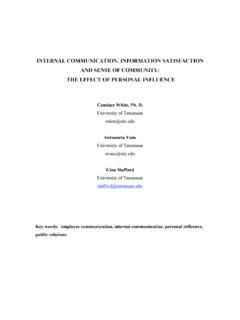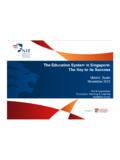Transcription of Small and Medium Enterprises in Korea: Achievements ...
1 Small and Medium Enterprises in korea : Achievements , constraints and policy Issues Jeffrey B. Nugent and Seung-Jae Yhee This paper provides an overview of the evolution of the Small and Medium enterprise sector in korea during the past quarter century. It shows how the industrial structure of korea has changed dramatically over this period to feature much greater shares in employment and value added by Small and Medium Enterprises (SMEs). It reviews the evidence on SME. dynamism showing that SMEs have contributed to the enormous transformations that have taken place in the Korean economy since 1975, especially with regard to exports, foreign investment and productivity performance.
2 It discusses the role of subcontracting as well as that of government and non-governmental institutions in supporting SME development. Finally, it examines the link between variations in the economic importance of SMEs and aspects of growth and inequality to assess whether SMEs function as business cycle shock absorbers and inequality-reducing mechanisms. World Bank Institute Copyright 2001. The International Bank for Reconstruction and Development/The World Bank 1818 H Street, Washington, 20433, First Printing June 2001. The World Bank enjoys copyright under protocol 2 of the Universal Copyright Convention. This material may nonetheless be copied for research, educational, or scholarly purposes only in the member countries of The World Bank.
3 Material in this series is subject to revision. The findings, interpretations, and conclusions expressed in this document are entirely those of the author(s) and should not be attributed in any manner to the World Bank, to its affiliated organizations, or the members of its Board of Executive Directors or the countries they represent. Small and Medium Enterprises in korea : Achievements , constraints and policy Issues Jeffrey B. Nugent and Seung-Jae Yhee 2001. 42 pages. Stock No. 37190. Contents Foreword v Changing Importance and Roles of SMEs Over Time 2. Productivity Change and Its Analysis 6. Firm Dynamics 13. External Sources of Support: Private Firms Through Subcontracting 18.
4 External Sources of Support: Government and Nongovernmental Institutions 21. SMEs as Business Cycle Shock Absorbers and Inequality-Reducing Devices 28. Conclusions and Lessons for Other Developing Countries 31. References 34. iii Foreword This paper was prepared for a project on the Role of Small & Medium Enterprises in East Asia. The project was organized by the World Bank Institute under the auspices of the Program for the Study of the Japanese Development Management Experience which is financed by the Human Resources Development Trust Fund established at the World Bank by the Government of Japan. The principal objectives of this Program are to conduct studies on Japanese and East Asian development management experience and to disseminate the lessons of this experience to developing and transition economies.
5 Typically, the experiences of other countries are also covered in order to ensure that these lessons are placed in the proper context. This comparative method helps identify factors that influence the effectiveness of specific institutional mechanisms, governance structures, and policy reforms in different contexts. A related and equally important objective of the Program is to promote the exchange of ideas among Japanese and non-Japanese scholars, technical experts and policy makers. The papers commissioned for this project cover a number of important issues related to SME growth and performance in the region. These issues include: the productivity of Small and Medium Enterprises , their adaptability to shocks and crises, their contribution to innovation and technological advance, their link to such features of the business environment as subcontracting and agglomeration, their impact on employment and equity, and their responsiveness to public policy .
6 Farrukh Iqbal, Program Manager World Bank Institute v Small and Medium Enterprises in korea : Achievements , constraints and policy Issues Jeffrey B. Nugent and Seung-Jae Yhee*. University of Southern California Virtually nowhere has the relative role of Small and Medium Enterprises (SMEs) in the country changed as much over time as in South korea (henceforth korea ). The role of its SMEs has gone through at least two very distinct phases, one of sharp decline (from the early 1960s to about 1976), and one in which that role has been gradually increasing (from 1976 to at least quite recently). With the currency and monetary crisis of 1997 99, and a relative decline in investment in SMEs since the mid-1990s, however, it is quite possible that the latter trend has been stalled and beginning to be reversed once again.
7 Whether this is only a temporary stall or a turning point to another period of relative SME decline remains to be seen and may hinge on the way in which the crisis is resolved. SMEs dominated the manufacturing sector of the economy in the early 1960s but by the mid-1970s, korea had become known for the extreme dominance in economic and public policy of its large chaebol (conglomerate) firms in the economy. Indeed, it had become so much large firm and chaebol-oriented that korea has often been contrasted with other East Asian economies like Japan and Taiwan where SMEs 1. have continued to play a comparatively much more important role.
8 Less well known is that since the mid- to-late 1970s there has been a steady decline in the dominance of large firms and a corresponding rise in the role of SMEs in all aspects of manufacturing activity. The dramatic rise of the chaebol and the Korean economy as a whole has been closely linked to an especially cozy relation between government and business and to the country's development strategy. Whether korea 's economic development has been helped or hurt by the country's development strategy is still hotly debated as is of course the extent to which the financial and currency crisis of the last two years can be attributed to the excessive power and international borrowing of the chaebol.
9 Even more controversial is what, if anything, should be done to correct the widely perceived excesses of the chaebol and government policies in support of them. Meanwhile, gradually and especially since the early 1980s, the Korean government has instituted a whole host of policies designed to assist SMEs. But, there is little evidence to date as to whether these policies have had any significant effects and, if so, whether or not these policies have been cost-effective in social terms. Coinciding with the resurgence in SME shares in manufacturing employment and exports, as will be demonstrated in Section 7 there has been a decline in income inequality.
10 If it could be shown that SME support policies were effective and that the trends in SME shares and income inequality were related, lower inequality could indeed be one social benefit of such policies. The purpose of this study is to identify Achievements , problems, and policy issues concerning korea 's SMEs. Attempts are made to deal with dynamic issues despite the lack of access to a panel dataset well suited for analyzing such issues. The Korean experience is bound to have important lessons for other developing countries for several reasons. First, because of the extremely rapid growth of the South Korean economy * The authors are deeply indebted and extremely grateful to Junkyu Lee and Sandra Manickam for able research assistance, to Be Yan Aw for gaining access to the results of yet unpublished work based on panel data, to numerous Korean officials, but especially Dr.
















